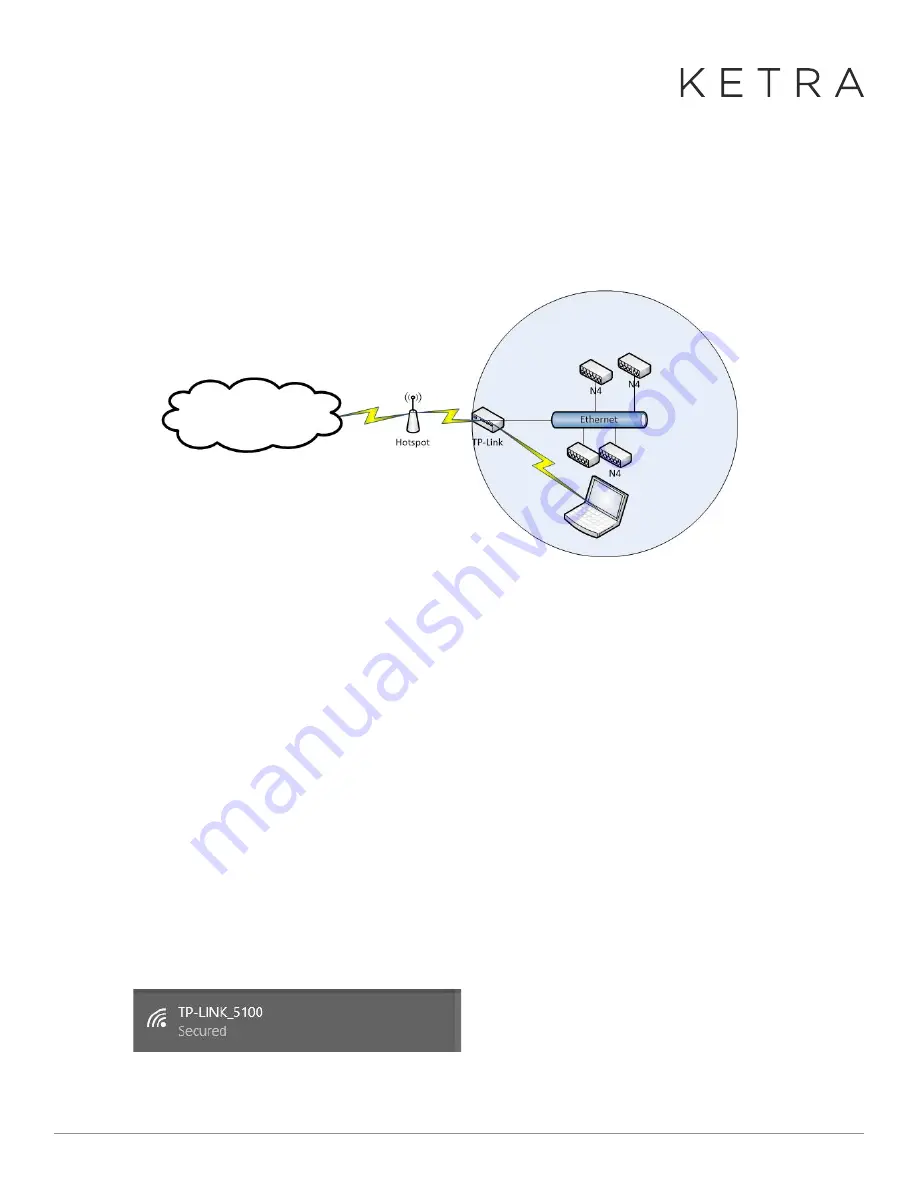
Designed in Austin, TX
512-347-1100 | ketra.com
©2017 Ketra, Inc. All rights reserved
The “Hotspot Router” mode creates an entirely new subnet and Wi-Fi network, and uses your hotspot’s Wi-Fi
network as the “WAN” connection. In this mode, the TP-Link is the DHCP server and you can connect a laptop to
the TP-Link’s Wi-Fi network and communicate with the devices on the ethernet LAN port. It is important to note
that if you connect the laptop to the Wi-Fi hotspot, you will not be able to communicate with the devices on the
TP-Link subnet.
So the primary difference between the two modes is that client mode uses the subnet of the hotspot, and
hotspot router mode creates a new subnet isolated from the hotspot. Normally, you can use either client mode
or hotspot router mode interchangeably, but the in the following circumstances you may want to choose one
over the other:
• If your hotspot’s Wi-Fi range is superior to the TP-Link’s, you may want to choose client mode and connect
your laptop to the hotspot
• If you are using an iPhone as the hotspot, it is generally better to use hotspot router mode, because of some
technical limitations in the iPhone’s hotspot (e.g., it does not support more than a handful of devices and will
actually stop working if you connect too many devices).
INSTRUCTIONS FOR SETTING UP CLIENT MODE
1.
Power on the WR810N and, if necessary, reset it to factory defaults by pressing the “
reset
” button until the
LED starts blinking
2.
On a laptop, connect to the Wi-Fi network of the TP-Link. The network name and password is printed on the
side of the unit.
Diagram
of
“Hotspot
Router”
Mode
So
the
primary
difference
between
the
two
modes
is
that
client
mode
uses
the
subnet
of
the
hotspot,
and
hotspot
router
mode
creates
a
new
subnet
isolated
from
the
hotspot.
Normally,
you
can
use
either
client
mode
or
hotspot
router
mode
interchangeably,
but
the
in
the
following
circumstances
you
may
want
to
choose
one
over
the
other:
● If
your
hotspot’s
Wi-Fi
range
is
superior
to
the
TP-Link’s,
you
may
want
to
choose
client
mode
and
connect
your
laptop
to
the
hotspot
● If
you
are
using
an
iPhone
as
the
hotspot,
it
is
generally
better
to
use
hotspot
router
mode,
because
of
some
technical
limitations
in
the
iPhone’s
hotspot
(e.g.,
it
does
not
support
more
than
a
handful
of
devices
and
will
actually
stop
working
if
you
connect
too
many
devices).
Instructions
for
setting
up
Client
Mode
● Power
on
the
WR810N
and,
if
necessary,
reset
it
to
factory
defaults
by
pressing
the
“reset”
button
until
the
LED
starts
blinking
● On
a
laptop,
connect
to
the
Wi-Fi
network
of
the
TP-Link.
The
network
name
and
password
is
printed
on
the
side
of
the
unit.
Diagram of “Hotspot Router” Mode
Internets
TP-Link Subnet
Diagram
of
“Hotspot
Router”
Mode
So
the
primary
difference
between
the
two
modes
is
that
client
mode
uses
the
subnet
of
the
hotspot,
and
hotspot
router
mode
creates
a
new
subnet
isolated
from
the
hotspot.
Normally,
you
can
use
either
client
mode
or
hotspot
router
mode
interchangeably,
but
the
in
the
following
circumstances
you
may
want
to
choose
one
over
the
other:
● If
your
hotspot’s
Wi-Fi
range
is
superior
to
the
TP-Link’s,
you
may
want
to
choose
client
mode
and
connect
your
laptop
to
the
hotspot
● If
you
are
using
an
iPhone
as
the
hotspot,
it
is
generally
better
to
use
hotspot
router
mode,
because
of
some
technical
limitations
in
the
iPhone’s
hotspot
(e.g.,
it
does
not
support
more
than
a
handful
of
devices
and
will
actually
stop
working
if
you
connect
too
many
devices).
Instructions
for
setting
up
Client
Mode
● Power
on
the
WR810N
and,
if
necessary,
reset
it
to
factory
defaults
by
pressing
the
“reset”
button
until
the
LED
starts
blinking
● On
a
laptop,
connect
to
the
Wi-Fi
network
of
the
TP-Link.
The
network
name
and
password
is
printed
on
the
side
of
the
unit.

























